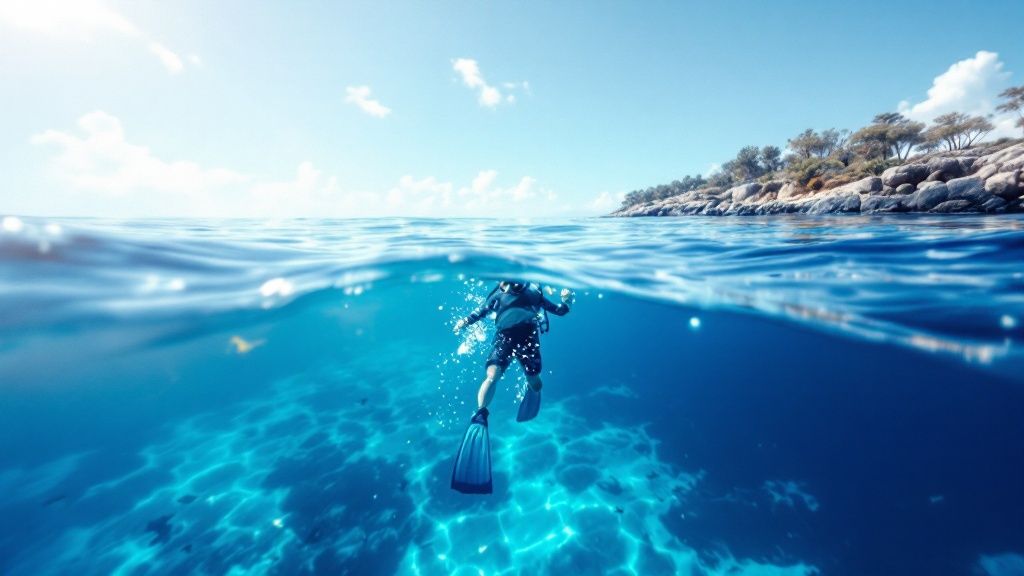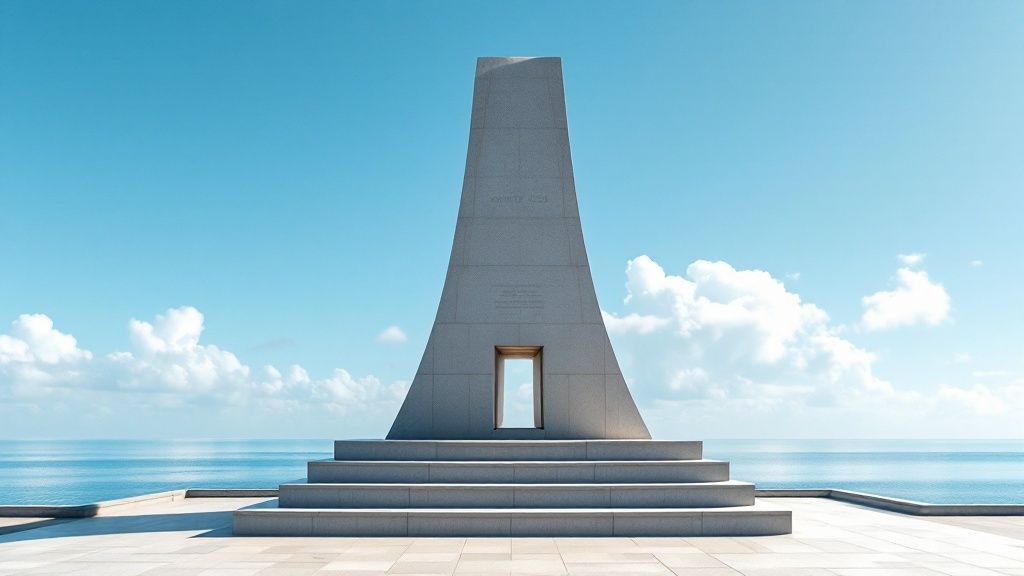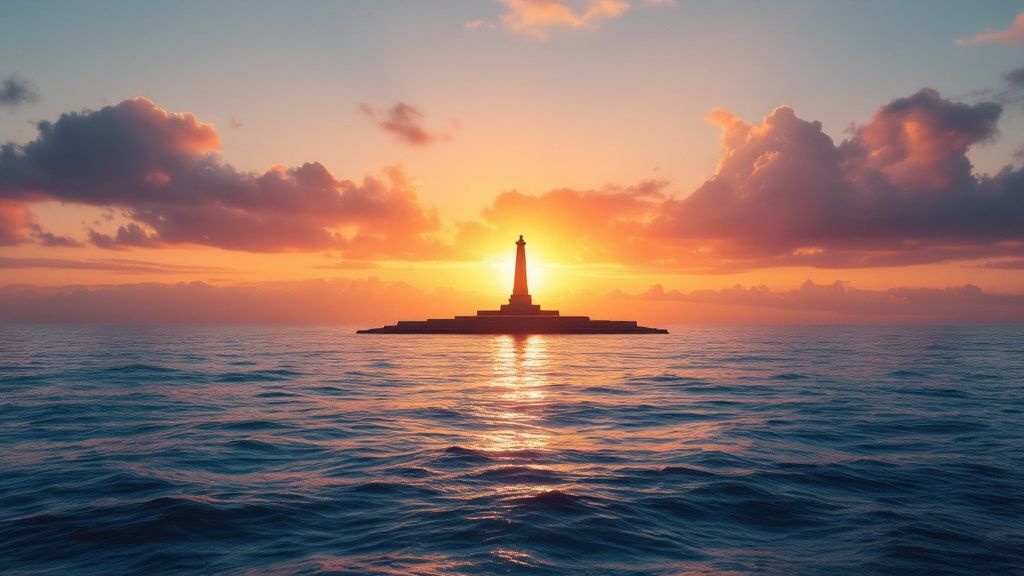Snorkeling Captain Cook Monument: Hawaiian Adventure

Why Snorkeling Captain Cook Monument Is an Unmissable Hawaii Experience
Snorkeling in Hawaii often brings to mind colorful coral reefs teeming with marine life. But snorkeling Captain Cook Monument in Kealakekua Bay offers something truly special. This location combines natural beauty with historical significance, resulting in a rich experience unlike any other in the islands. The bay’s sheltered location creates exceptionally calm waters, ideal for both experienced snorkelers and beginners.
This tranquility also contributes to the site's remarkable visibility. Kealakekua Bay is known for its water clarity, often exceeding 100 feet. This allows snorkelers to fully appreciate the vibrant coral reefs and diverse marine life. This amazing clarity is partly due to underwater freshwater springs that act as natural filters. The bay’s unique topography also shields it from strong waves, further enhancing the pristine conditions. Thousands of snorkelers visit the monument each year, attracted by its natural beauty and historical significance as Captain James Cook's first landing site in Hawaii in 1779. Learn more about the Captain Cook Monument here.
Exploring a Unique Underwater Ecosystem
Beyond the exceptional visibility, the underwater world at Captain Cook Monument is truly remarkable. Freshwater springs flowing into the bay create a unique ecosystem. This blend of fresh and saltwater supports a wide array of marine life, offering snorkelers a glimpse into a unique ecological interaction. You might see colorful reef fish darting among the coral, or encounter larger pelagic species attracted to the bay's abundance of nutrients.
This dynamic environment showcases the delicate balance of nature. It provides a truly immersive experience for snorkelers of all skill levels. You might also be interested in: our sitemap for more snorkeling adventures.
The Best Way to Experience the Monument
For an unforgettable snorkeling experience at Captain Cook Monument, consider a tour with Captain Cook Snorkeling Tours. They offer comfortable and enriching excursions led by knowledgeable guides who emphasize safety and education. Their local expertise allows them to navigate the bay efficiently. This ensures you experience the best snorkeling spots and learn about the area’s unique characteristics.
This personalized approach enhances the experience, allowing you to connect with the environment on a deeper level.
A Memorable Underwater Journey
Snorkeling Captain Cook Monument is more than just an activity; it’s an immersion into a special blend of nature, history, and culture. The combination of stunning underwater scenery, diverse marine life, and the historical significance of the site creates a lasting memory for all who visit. From beginners to experienced snorkelers, this location is consistently ranked among the most memorable underwater experiences.
The monument serves as a powerful reminder of Hawaii's rich history and the importance of protecting its natural wonders.

Accessing Paradise: Your Options for Reaching the Monument
The journey to snorkel at the Captain Cook Monument is an adventure in itself. Choosing the right transportation adds another layer to the experience. From comfortable boat tours to challenging hikes, there are several ways to reach this underwater paradise. Let's explore the most common methods, weighing the pros and cons of each.
Boat Tours: Comfort and Convenience
Boat tours are by far the most popular way to reach the monument. They offer a quick, comfortable trip across Kealakekua Bay, maximizing your snorkeling time. Captain Cook Snorkeling Tours is a standout provider, offering expert guidance for a safe and educational experience. Their local expertise ensures you'll find the prime snorkeling locations within the bay. This approach minimizes travel time and maximizes enjoyment, especially for families or those who prefer a less strenuous journey. However, boat tours typically come at a higher price than other options.
Kayaking: An Active Adventure
Kayaking to the monument offers a more active and immersive experience. You'll paddle across the bay, enjoying the scenery and getting a workout. This method offers flexibility to explore at your own pace. However, the journey can be physically demanding, especially in warm weather. Kayaking also requires some experience and comfort in open water. This option is best for adventurous individuals with a decent fitness level. Remember to check weather conditions and water currents.
Hiking: A Challenging Trek
For the truly adventurous, hiking to the monument is a rewarding, if challenging, choice. The 4-mile roundtrip hike descends a steep, rugged cliff with breathtaking views. This option is free (excluding potential parking fees). However, it requires significant physical exertion and can be dangerous in bad weather. This hike is recommended only for experienced hikers in good physical shape.
To help plan your snorkeling adventure, check out our sitemap for additional helpful information.
Choosing the Right Path
Before we summarize your options, let's look at a detailed comparison to help you make the best decision for your trip. The following table outlines the key features of each transportation method:
To help you choose the best fit, here’s a comparison of the different transportation options:
Transportation Options to Captain Cook Monument
Comparison of different ways to reach the monument for snorkeling, with key details about each method
| Access Method | Approximate Cost | Duration | Physical Effort | Permits Required | Pros | Cons |
|---|---|---|---|---|---|---|
| Boat Tour | $100 – $150 | 15-20 minutes each way | Minimal | No | Convenient, fast, access to prime locations, guided experience | Most expensive option |
| Kayaking | $50 – $75 per kayak rental | 1-2 hours each way | Moderate to High | May be required depending on launch location | Active, immersive, flexible exploration | Physically demanding, experience needed, affected by weather |
| Hiking | Free (parking fees may apply) | 2 hours each way | High | No | Rewarding views, free access | Strenuous, time-consuming, can be dangerous in poor weather |
As you can see, each option offers a unique set of advantages and disadvantages. Boat tours are the quickest and easiest, while kayaking provides a balance of activity and exploration. Hiking offers a challenging but free adventure.

Ultimately, the best way to reach the Captain Cook Monument depends on your preferences, physical abilities, and budget. Consider your priorities to choose the method that best suits your needs.
Beneath the Surface: Kealakekua Bay's Underwater Wonderland
Stepping into Kealakekua Bay is like entering another world. Snorkeling at Captain Cook Monument puts you right in the heart of this vibrant underwater universe. It's a thriving ecosystem teeming with life, and we're going to explore its magic with the help of underwater photographers and marine biologists.
A Kaleidoscope of Reef Fish
Snorkeling in Kealakekua Bay is captivating. The diversity of reef fish is astounding. Brightly colored parrotfish crunch on coral, while the elusive Moorish idol, with its distinctive dorsal fin, darts through the water. Each fish adds to a breathtaking underwater tapestry. Understanding their unique patterns and behaviors gives you a deeper appreciation for the delicate balance of this special ecosystem. For instance, the yellow tang, a vibrant yellow surgeonfish, plays a crucial role in maintaining the reef’s health by grazing on algae.
Coral Gardens: Homes to Biodiversity
Coral formations are the foundation of this underwater city. They aren't just beautiful structures; they're teeming with life. Different corals host various communities. Branching corals provide shelter to smaller fish, while larger, complex formations are home to bigger species, like the Hawaiian green sea turtle. Knowing which corals support the most life adds another layer to your snorkeling adventure. It's all interconnected in a complex web.
To give you a better idea of the marine life you can expect to see when snorkeling around the monument, we've put together this handy spotting guide:
Marine Life Spotting Guide at Captain Cook Monument
Common marine species found when snorkeling at the monument, with identifying features and where to spot them.
| Species | Identifying Features | Where to Look | Best Time to See | Frequency |
|---|---|---|---|---|
| Hawaiian Green Sea Turtle (Honu) | Large, greenish-brown shell, strong flippers | Near coral reefs, seagrass beds | Early morning, late afternoon | Common |
| Yellow Tang (Lau'ipala) | Bright yellow body, scalpel-like spines on tail | Shallow reefs, near coral heads | Daytime | Abundant |
| Parrotfish (Uhu) | Fused teeth forming a beak-like mouth, vibrant colors (vary by species and maturity) | Coral reefs, grazing on algae | Daytime | Common |
| Moorish Idol (Kihikihi) | Distinctive black, white, and yellow markings, long, trailing dorsal fin | Near coral reefs, often in pairs | Daytime | Occasional |
| Reef Triggerfish (Humuhumunukunukuapua'a) | Oval-shaped body, small mouth, colorful patterns | Near coral reefs, often in crevices | Daytime | Common |
This table highlights some of the more common species you’re likely to encounter, giving you a starting point for your underwater explorations. Keep an eye out for their unique characteristics, and you’ll gain a deeper appreciation for the diversity of Kealakekua Bay.

Secrets of the Bay: Tips for Spotting Elusive Creatures
Experienced photographers who frequent Kealakekua Bay have learned the tricks for spotting elusive creatures. Knowing the prime times for seeing certain species and how seasonal changes affect marine life increases your chances of a memorable sighting. For example, during the summer months, the bay becomes a nursery for juvenile fish. This offers a rare chance to observe the next generation of reef life. Early morning snorkeling often brings better visibility and calmer waters. For more detailed information on the area, you might find the Kona Snorkel Trip’s sitemap helpful.
Experiencing the Bay with Captain Cook Snorkeling Tours
For a truly unforgettable experience, consider booking a tour with Captain Cook Snorkeling Tours. Their expert-led excursions focus on safety and enjoyment. They offer valuable insights into the bay's unique features and diverse marine life. Their local knowledge ensures you see the best spots and gain a deeper understanding of this vital ecosystem.
Conservation: Protecting a Precious Resource
Beyond the thrill of identifying species, understanding the conservation efforts in Kealakekua Bay is crucial. This isn’t just a pretty place to snorkel; it’s a vital ecosystem that needs our protection. By practicing responsible snorkeling and supporting initiatives, we can help ensure its wonders endure for generations to come. This transforms a simple snorkeling trip into a meaningful way to preserve Hawaii’s unique marine heritage.
Planning Your Perfect Snorkeling Adventure at Captain Cook
Transforming your snorkeling trip at Captain Cook Monument from ordinary to extraordinary begins with a well-thought-out plan. From the moment you arrive to choosing the right gear, every detail contributes to a truly remarkable adventure. This guide offers valuable tips, gleaned from seasoned tour operators and regular visitors, to ensure your snorkeling trip is everything you've hoped for.
Booking Your Snorkeling Tour
For a truly enriching experience, consider reserving a tour with Captain Cook Snorkeling Tours (https://www.captaincooksnorkelingtours.com/). Booking a morning time slot is often recommended, as the earlier you arrive, the clearer the water and the fewer the crowds. Their experienced guides not only lead you to the prime snorkeling locations but also share valuable knowledge about the area's history, diverse marine life, and the delicate ecosystem. This personalized touch adds a unique dimension to your underwater exploration.
Essential Gear for Your Trip
Packing the correct gear can significantly enhance your snorkeling adventure. A mask, snorkel, and fins are the foundation of your gear. Consider bringing a rash guard or wetsuit for sun protection and warmth, particularly during the cooler months. Water shoes are helpful for navigating the rocky shoreline. An underwater camera can capture amazing memories.
Avoid bringing bulky or complicated equipment, especially if you are a beginner. Focus on enjoying the present moment and truly appreciating the underwater beauty surrounding you.
Choosing the Right Time to Visit
Kealakekua Bay, while sheltered, is still affected by weather. The summer months typically offer the calmest waters and best visibility. However, each season has unique underwater features. Winter brings the exciting chance of whale sightings, while spring and fall present a balance of good weather and smaller crowds. Researching typical water temperatures and seasonal marine life activity can help you choose the ideal time for your interests.
Kealakekua Bay: What to Expect
Kealakekua Bay maintains its natural beauty partly due to limited development. This means facilities like restrooms and other amenities can be limited. Be prepared by bringing water, snacks, and any necessary personal items. Be mindful of waste disposal and adhere to Leave No Trace principles to protect the bay's pristine environment.
The Captain Cook Monument is more than just a historical landmark; it's a symbol of human exploration and the meeting of different cultures. It's also a significant tourist attraction, with approximately 190,000 visitors drawn to Kealakekua Bay annually. This influx highlights the critical need to find a balance between tourism and environmental preservation. Ongoing discussions about sustainable tourism practices, including visitor fees and limits on group sizes, emphasize the importance of responsible travel. Learn more about the efforts to preserve this special place here.
Capturing Memories Responsibly
Underwater photography offers a fantastic way to remember your snorkeling adventure. Remember to prioritize safety and respect for the marine environment. Avoid touching coral or disturbing marine life while trying to take the perfect picture. Consider a waterproof camera with a wrist strap for easy handling.
Strive to balance capturing memories with simply being present and enjoying the experience. Sometimes, the most vivid memories are the ones you hold in your mind.

By following these planning tips, you can create a genuinely unforgettable snorkeling experience at Captain Cook Monument, one that combines stunning underwater beauty with a deep appreciation for the area’s history and ecological significance.
Staying Safe While Snorkeling Captain Cook Monument
Snorkeling at Captain Cook Monument in Kealakekua Bay is an incredible experience. But before you jump in, it's essential to prioritize safety. The bay has unique conditions, and understanding them is key to a fun and worry-free adventure. This guide, drawing on expertise from water safety professionals and the local guides at Captain Cook Snorkeling Tours, will help you prepare.
Essential Snorkeling Skills
Before you head out, ensure you're comfortable with basic snorkeling skills. This includes breathing through the snorkel, clearing water from the tube, and using your fins efficiently. These techniques are crucial for conserving energy, particularly if you encounter currents. For a refresher or to learn more, check out this helpful guide on snorkeling basics and advanced techniques. Practicing in a calm area, like a pool or shallow beach, is highly recommended before venturing into the bay.
Recognizing Changing Conditions
While generally calm, conditions in Kealakekua Bay can change. Knowing how to spot these shifts is vital. Look out for increasing wave height, shifting wind direction, or a sudden change in water temperature. These can indicate changing weather patterns and should prompt you to assess whether to continue snorkeling or return to shore.
Sun Protection: Protecting Yourself and the Reef
Hawaii's sun is intense, making sun protection essential. However, many sunscreens contain chemicals that harm coral reefs. Opt for reef-safe sunscreen, which is formulated without oxybenzone and octinoxate. This protects both your skin and Kealakekua Bay’s fragile ecosystem. Consider adding a rash guard or wetsuit for extra sun protection and added warmth in cooler water.
Marine Life Interaction: Respectful Observation
Kealakekua Bay boasts a vibrant ecosystem. Remember to interact with marine life respectfully. Avoid touching the coral, as even light contact can damage it. Never attempt to feed or harass marine animals. Maintaining a respectful distance allows for observation without disturbing their natural behavior. This also ensures your own safety, as some marine creatures can be dangerous if provoked.
Group Awareness and Communication
Snorkeling with a buddy or group increases safety. Stay aware of your surroundings and keep your companions in sight. Before you enter the water, establish clear communication signals, especially if you aren't on a guided tour. This will allow you to quickly alert others to potential hazards or signal for help if needed.
Age and Experience Considerations
Safety precautions vary depending on age and experience. Children should always be supervised by a capable adult, ideally one with snorkeling experience. Beginners should start in shallow, calm water before venturing further. Those with medical conditions should consult a doctor before snorkeling and inform their tour guide or companions of any special needs.
By following these safety guidelines, your snorkeling experience at Captain Cook Monument will be both memorable and safe. Preparation, awareness, and respect for the environment are key to a rewarding adventure. With a bit of planning and a focus on safety, you can fully appreciate the wonder and beauty of Kealakekua Bay.
Beyond The Water: The Cultural Legacy of Captain Cook Monument
Kealakekua Bay isn't just a picturesque snorkeling spot. It holds deep historical and cultural importance for the Hawaiian people. The monument commemorating Captain James Cook's arrival represents a pivotal moment, interpreted differently through Western and indigenous Hawaiian perspectives. Understanding these varied viewpoints adds significant depth to any visit, enriching the experience beyond the vibrant marine life.
A Clash Of Cultures: Cook's Arrival And Its Impact
Captain Cook's 1779 arrival wasn't simply a "discovery." It was a convergence of vastly different cultures, irrevocably changing the trajectory of Hawaiian history. Western narratives often portray Cook as a celebrated explorer. However, Native Hawaiian traditions offer a contrasting narrative. For some, his arrival disrupted a long-standing societal harmony. This cultural clash is essential to grasping the monument's true meaning. It serves as a poignant reminder of a multifaceted past. For a comfortable and informative visit, consider booking a snorkeling tour with Captain Cook Snorkeling Tours.
The Monument: Multiple Meanings
The Captain Cook Monument carries diverse interpretations. For some, it memorializes a significant historical event. For others, it symbolizes the beginning of a tumultuous era for Hawaiian culture. This duality makes the site a compelling space for contemplation and dialogue. It's not merely a tourist destination; it's a place to learn, reflect, and understand. The monument stands as a physical representation of a complex historical narrative.
Honoring The Past, Embracing The Present
Today, Kealakekua Bay retains its profound cultural significance. Native Hawaiians maintain a strong connection to this land and its surrounding waters. Respectful visitors can honor this connection by learning about the area's rich history and traditions. Experiencing the bay's natural beauty should be coupled with an appreciation for its cultural heritage. This mindful approach elevates a snorkeling trip into a culturally enriching journey.
Respectful Visitation: A Shared Responsibility
Visiting the monument is both a privilege and a responsibility. Understanding the cultural context is paramount to being a respectful guest. Simple acts, such as observing quiet reverence near the monument, refraining from climbing on it, and respecting local customs, demonstrate an awareness of the site's profound importance. This thoughtful approach ensures visitors contribute to preserving the historical and cultural heritage of Kealakekua Bay for generations to come. By acknowledging and honoring these traditions, visitors participate in a collective effort to safeguard the bay's legacy.
Preserving Paradise: Responsible Snorkeling at Captain Cook
Snorkeling at Captain Cook Monument isn't just a fun way to spend an afternoon; it's a true privilege. Kealakekua Bay pulsates with life and holds deep cultural meaning, requiring respect and care from each visitor. Understanding the bay’s delicate balance and practicing sustainable snorkeling will help ensure its beauty thrives for generations to come. Captain Cook Snorkeling Tours provides a fantastic way to experience this special place while supporting responsible tourism.
Reef-Safe Practices: Protecting Fragile Ecosystems
Coral reefs are surprisingly fragile ecosystems. Even the lightest touch can inflict significant damage. Therefore, reef-safe snorkeling is paramount. Here are some essential practices:
- Maintaining a safe distance: Resist the urge to touch the coral, even if it seems robust. Think of it as a vibrant underwater garden, where each delicate bloom is vulnerable to a careless touch.
- Proper finning: Be aware of your fin kicks, especially in shallower waters. Gentle kicks prevent stirring up sediment and minimize the risk of accidental coral contact.
- No anchoring on coral: Boats should always use designated mooring buoys or anchor in sandy patches well away from coral formations.
Sunscreen Selection: Making a Difference
Your sunscreen choice directly affects Kealakekua Bay’s health. Common sunscreen ingredients like oxybenzone and octinoxate are known to be harmful to coral. Instead, select reef-safe sunscreens with mineral-based ingredients such as zinc oxide or titanium dioxide. These provide excellent sun protection without the detrimental environmental impact. For more detailed information, explore this guide on choosing reef-safe sunscreen.
Community Conservation Efforts
The local community is actively involved in preserving Kealakekua Bay. Dedicated organizations and volunteers regularly organize cleanup initiatives, monitor reef health, and educate visitors on responsible practices. As visitors, we can support these efforts by:
- Participating in beach cleanups: Even a short time spent collecting debris makes a tangible difference.
- Respecting local guidelines: Following designated snorkeling areas and showing respect for cultural sites contributes to the bay’s overall well-being.
- Supporting local businesses: Choosing eco-conscious tour operators, like Captain Cook Snorkeling Tours, reinforces the importance of sustainable tourism.
By actively participating in these simple yet impactful practices, you elevate your snorkeling trip from a fun activity to a meaningful act of preservation. You help ensure the wonder of Kealakekua Bay continues to flourish. Ready to embark on an unforgettable and eco-friendly snorkeling adventure? Book with Kona Snorkel Trips today!
